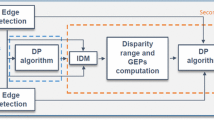Abstract
Stereo matching is one of the fundamental problems in computer vision. It consists in identifying features in two or more stereo images that are generated by the same physical feature in the three-dimensional space. This paper presents an evolutionary approach with a multilevel searching strategy for matching edges extracted from two stereo images. The matching problem is turned into an optimization task, which is performed by means of a genetic algorithm with a new encoding scheme. For an effective exploitation of the genetic stereo matching algorithm for real-time obstacle detection, a multilevel searching strategy is proposed to match the edges at different levels by considering their gradient magnitudes. Experimental results and comparative analysis are presented to demonstrate the effectiveness of the proposed method for real-time obstacle detection in front of a moving vehicle using linear stereo vision.
Similar content being viewed by others
References
Marr D, Poggio T (1976) Cooperative computation of stereo disparity. Science 194:283–287
Barnard ST, Thompson WB (1980) Disparity analysis of images. IEEE Trans Pattern Anal Mach Intell (2)4:333–340
Ballard DH, Brown CM (1982) Computer vision. Englewood Cliffs, Prentice Hall
Dhond UR, Aggarwal JK (1989) Structure from stereo—a review. IEEE Trans Man Cybernet 19:1489–1510
Jähne B, Haußecker H (2000) Computer vision and applications. Academic, New york
Barnard S, Fisher M (1982) Computational stereo. ACM Comput Surv 14:553–572
Dooze D (2001) Conception et réalisation d’un stéréoscope bimodal à portée variable: application à la détection d’obstacles à l’avant de véhicules guidés automatisés. PhD Thesis, Université des Sciences et Technologies de Lille
Haralick RM, Shapiro LG (1992) Image matching, computer and robot vision, part 2. Addison-Wesley, New York
Scharstein D, Szeliski R (2002) A taxonomy and evaluation of dense two-frame stereo correspondence algorithms. Int J Comput Vis (47)1–3:7–42
Saito H, Mori M (1995) Application of genetic algorithms to stereo matching of images. Pattern Recognit Lett 16:815–821
Han KP, Song KW, Chung EY, Cho SJ, Ha YH (2001) Stereo matching using genetic algorithm with adaptive chromosomes. Pattern Recognit 34:1729–1740
Tang L, Wu C, Chen Z (2002) Image dense matching based on region growth with adaptive window. Pattern Recognit Lett 23:1169–1178
Lee SH, Leou JJ (1994) A dynamic programming approach to line segment matching in stereo vision. Pattern Recognit Lett 8(27):961–986
Lee K, Lee J (2004) Genetic obstacle detection on roads by dynamic programming for remapped stereo images to an overhead view. In: Proceedings of the IEEE International Conference on Networking, Sensing and Control, Taipei, Taiwan, pp 897–902
Nasrabadi NM (1992) A stereo vision technique using curve-segments and relaxation matching. IEEE Trans Pattern Anal Mach Intell 5(14):566–572
Tien FC (2004) Solving line-feature stereo matching with genetic algorithms in Hough space. Journal of the Chinese Institute of Industrial Engineers 5(21):515–526
Pajares G, de la Cruz JM (2004) On combining support vector machines and simulated annealing in stereovision matching. IEEE Trans Man Cybern Part B 4(34):1646–1657
Candocia F, Adjouadi A (1997) A similarity measure for stereo feature matching. IEEE Trans Image Processing 6:1460–1464
Starink JPP, Backer E (1995) Finding point correspondences using simulated annealing. Pattern Recogn 2(28):231–240
Wang JH, Hsiao CP (1999) On disparity matching in stereo vision via a neural network framework. Proc Natl Sci Counc ROC(A) 5(23):665–678
Zhang P, Lee DJ, Beard R (2004) Solving correspondence problems with 1-D signal matching. In: Casasent DP, Hall EL, Roning J (eds) Intelligent robots and computer vision XXII: Algorithms, techniques and active vision. Proceedings of the SPIE 5608, Philadelphia, pp 207–217
Kriegman DJ, Triendl E, Binford TO (1989) Stereo vision and navigation in buildings for mobile robot. IEEE Trans Robot Autom 6(5):792–803
Nitzan D (1988) Three–dimensional vision structure for robot application. IEEE Trans Pattern Analy Mach Intell 3(10): 291–309
Bruyelle JL, Postaire JG (1993) Direct range measurement by linear stereo vision for real-time obstacle detection in road traffic. Robo Auton Syst 11:261–268
Inigo RM, Tkacik T (1987) Mobile robot operation in real-time with linear image array based vision. In: Proceedings of the IEEE Intelligent Control Symposium, pp 228–233
Colle O (1990) Vision stéréoscopique à l’aide de deux cameras linéaires: application à la robotique mobile.PhD Thesis, Institut National des Sciences Appliquées de Lyon, France
Burie JC, Bruyelle JL, Postaire JG (1995) Detecting and localising obstacles in front of a moving vehicle using linear stereo vision. Math Comput Model 4–7(22):235–246
Ruichek Y, Postaire JG (1996) A neural matching algorithm for 3–D reconstruction from stereo pairs of linear images. Pattern Recognit Lett 17: 387–398
Ruichek Y, Postaire JG, Bruyelle JL (1998) A neural approach for obstacle detection with a linear stereoscopic sensor. Math Comput Model 9–11(27):215–228
Ruichek Y, Postaire JG (1999) A new neural real-time implementation for obstacle detection using linear stereo vsion. Real Time Imaging 5:141–115
Goldberg D (1989) Genetic algorithms in search, optimization and machine learning. Addison-Wesley, Reading
Ruichek Y, Issa H, Postaire JG (2000) Genetic approach for obstacle detection using linear stereo vision. Proceedings of the IEEE Intelligent Vehicles Symposium, pp 261–266
Bruyelle JL (1994) Conception et réalisation d’un dispositif de prise de vue stéréoscopique linéaire: Application à la détection d’obstacles à l’avant des véhicules routiers. PhD thesis, Université des Sciences et Technologies de Lille, France
Deriche R (1990) Fast algorithms for low-level vision. IEEE Trans Pattern Anal Mach Intell 1(12):78–87
Author information
Authors and Affiliations
Corresponding author
Rights and permissions
About this article
Cite this article
Ruichek, Y., Issa, H. & Postaire, JG. An Evolutionary-Based Stereo Matching Method with a Multilevel Searching Strategy. Soft Comput 10, 1145–1159 (2006). https://doi.org/10.1007/s00500-005-0037-3
Published:
Issue Date:
DOI: https://doi.org/10.1007/s00500-005-0037-3




